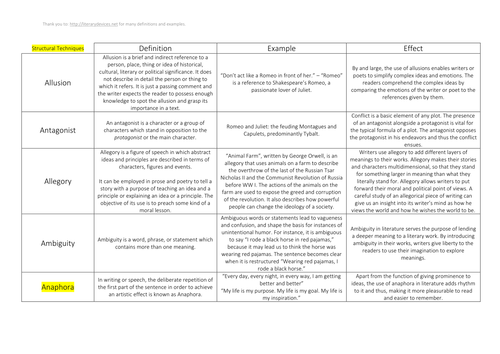
Here is a grid for KS4 students to use alongside the study of the new AQA English Language and Literature GCSE.
The grid consists of literary AND structural techniques (highlighted in yellow), definitions of each technique, example/s of each technique as well as the effect of the technique upon the reader.
I have found the EFFECTS column incredibly useful with my students to stop them saying, "to make the reader read on".
Where possible, I have tried to link the examples to the texts students may be studying for the new AQA GCSE.
Please let me know if you have found this grid useful or think there need to be changes or additions in the reviews section below. Thanks!
The grid consists of literary AND structural techniques (highlighted in yellow), definitions of each technique, example/s of each technique as well as the effect of the technique upon the reader.
I have found the EFFECTS column incredibly useful with my students to stop them saying, "to make the reader read on".
Where possible, I have tried to link the examples to the texts students may be studying for the new AQA GCSE.
Please let me know if you have found this grid useful or think there need to be changes or additions in the reviews section below. Thanks!
Something went wrong, please try again later.
This is a very comprehensive list of literary techniques. What makes it different to others available (and great for senior teachers!) is that it analyses the general effect these literary techniques have on an audience. Thanks for the great resource!
Report this resourceto let us know if it violates our terms and conditions.
Our customer service team will review your report and will be in touch.
£3.00
